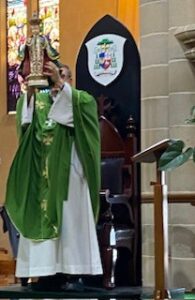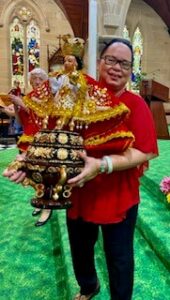Filipinos Celebrate “Sinulog,” The Feast of Santo Niño
16 February, 2024Filipinos Celebrate “Sinulog,” The Feast of Santo Niño
 “Sinulog” (“water movement”) is the Filipino term given to the celebration of the Feast of the Child Jesus or Santo Niño, commemorating the introduction of Christianity to the Philippines by Ferdinand Magellan, a Portuguese navigator commissioned by the then King Phillip of Spain. Magellan landed on the shores of Cebu in Central Visayas of the Philippine Archipelago on 21st March 1521. Cebu was then under the rule of Rajah Humabon, who along with his wife Hara Amihan and their subjects, agreed to be converted and baptised to the Christian Faith.
“Sinulog” (“water movement”) is the Filipino term given to the celebration of the Feast of the Child Jesus or Santo Niño, commemorating the introduction of Christianity to the Philippines by Ferdinand Magellan, a Portuguese navigator commissioned by the then King Phillip of Spain. Magellan landed on the shores of Cebu in Central Visayas of the Philippine Archipelago on 21st March 1521. Cebu was then under the rule of Rajah Humabon, who along with his wife Hara Amihan and their subjects, agreed to be converted and baptised to the Christian Faith.
As a gift for the occasion, Ferdinand Magellan gave the couple the image of Santo Niño along with the Magellan Cross. These gifts became the symbol of Christianity and are still held and venerated at the Basilica Menor in Cebu City, Philippines. Pope Paul VI elevated the Church to the status of Minor Basilica on its 400th anniversary. The Image of Santo Niño and the Magellan Cross are the oldest surviving Catholic relics in the Philippines.
Filipinos throughout the world honour the image of Sto Niño as thanksgiving for all the blessings and of good health and prosperity. The celebrations are held through January that starts from the Basilica Menor de Cebu, Philippines where devotees perform the “Sinulog” a Cebuano term roughly translated as “water movement.” Thus, devotees of the Santo Niño follow a certain step mimicking the water movement whilst carrying their own image of the Santo Niño. The simple dance movement reflects the enjoyment and pleasure of a child, as Santo Niño Devotees cheer “Viva Santo Niño!” (“Hail Santo Niño!”) and “Pit Señor!” (“Hear us Señor!”).
“Sinulog 2024” was celebrated at St Joseph’s Cathedral during the 9.30 Mass on Sunday, 28th January 2024, presided by Bishop Michael McCarthy, where the Filipino Community in Rockhampton shared their faith rich in culture and tradition.
The following is the homily Deacon Peter Doherty preached for the Celebration.
Santo Niño de Cebú
Det 18:15-20 | 1 Cor 7:32-35 | Mark 1: 21-28
We are celebrating today the Feast of Santo Nino de Cebu; this is a title of the image of the Christ-Child which tradition holds was presented by Ferdinand Magellan to the rulers of the Filipino Kingdom of Cebu – Carlos Humabon and Juana Humamay – on the occasion of their baptism in 1521.
It is therefore for all of us here a reminder of our sense of communion with all the local Churches of the dioceses in the Philippines – our brothers and sisters with whom we share a common baptism.
It also for us here in the city of Rockhampton but also for the entire Diocese a visible expression of the faithful and joyful witness and contribution that those of us who share a Filipino heritage make to the life of the local Churches in the dioceses across Australia. Their witness strengthens and brightens the Church and has become a communal accompaniment for all who bear the name of Christian.
It is then through the lens of this Feast of Santo Nino de Cebu that we can explore the readings of today.
In the first reading from the Book of Deuteronomy (Deut 18:15-20), Moses speaks to the people of Israel about a prophet whom God will raise up. This prophet is one to whom the people must listen. The Santo Niño de Cebú, as a symbol of Christ’s innocence and purity, represents that prophet foretold by Moses. In the figure of Santo Niño, we encounter a profound invitation to listen to the teachings of Jesus, to follow His example, and to embrace the childlike trust with which he calls all of us to accept his invitation.
The Gospel passage from Mark (Mark 1:21-28) reveals the authority of Jesus over unclean spirits – over all that attempts to possess us and keep us from having an encounter with the divine. As Jesus enters the synagogue, the people are astonished at His teaching, for He speaks with a new authority—one that penetrates hearts and overcomes evil. The encounter with the man possessed by an unclean spirit underscores the power of Christ over all that seeks to separate us from God. The image of the Santo Niño, in His innocence, reminds us of the purity and power of Christ’s teachings, which have the authority to free us from the grip of sin and darkness, and so embrace and live out faithfully again our own identity as children of God.
In St. Paul’s letter to the Corinthians (1 Cor 7:32-35), we hear about the advantages of being undivided in our devotion to the Lord. St. Paul encourages us to be free from anxieties and to focus on the things of the Lord. The childlike faith embodied in the Santo Niño teaches us the simplicity and sincerity of devotion. Like the child who trusts completely in the care of loving parents, we are called to entrust ourselves wholeheartedly to the Lord, unburdened by unnecessary worries, and centred on His will.
So, we can see perhaps that for us here today, the Feast of Santo Niño de Cebú is a celebration of our own baptism – the same baptism received by Carlos and Juana in 1521. Today’s readings then together with the Feast of Santo Nino de Cebu offers three themes which we might prayerfully reflect upon in the week to come:
First – through the image of the Santo Niño, we are invited to recultivate a childlike trust in God. In our journey of faith, we all encounter uncertainties and challenges. As we face these, let us in seeing the image of Santo Nino, see the one to whom it points – Jesus our friend, brother and saviour – who knows and cares for us beyond measure.
Secondly, in a world filled with competing voices and distractions which can at times seem to possess us, may the image of Santo Nino inspire us to make an intentional effort to be ourselves the prophetic voice of Christ in the world. Through our shared baptism, we all participate in the prophetic office of Christ – let us therefore speak boldly into that which possesses the world and prevents it from embracing the fullness of the Good News.
Thirdly, as Christian men and women, whatever our circumstances or state of life, let us be encouraged to be undivided in our devotion to the Lord. The simplicity of the childlike faith embodied in the image of Santo Niño calls us to prioritize our relationship with God above all else. In the midst of life’s busyness and distractions, let us strive for an undivided heart that seeks God’s will in all things.
 The Feast of Santo Nino de Cebu has therefore become not simply a moment that belongs to the traditions of our Filipino brothers and sisters – but rather a gift from our Filipino brothers and sisters to all of us – enriching the vibrancy and dynamism of our local Church. It is therefore a visible expression of the communion that we all share with each other and the communion of love and friendship that God constantly calls and invites us into and then to live out faithfully in the midst of the world.
The Feast of Santo Nino de Cebu has therefore become not simply a moment that belongs to the traditions of our Filipino brothers and sisters – but rather a gift from our Filipino brothers and sisters to all of us – enriching the vibrancy and dynamism of our local Church. It is therefore a visible expression of the communion that we all share with each other and the communion of love and friendship that God constantly calls and invites us into and then to live out faithfully in the midst of the world.
Viva Pit Senyor – Long Live the Christ Child!
________________________________________

